This article was co-authored by wikiHow Staff. Our trained team of editors and researchers validate articles for accuracy and comprehensiveness. wikiHow's Content Management Team carefully monitors the work from our editorial staff to ensure that each article is backed by trusted research and meets our high quality standards.
There are 14 references cited in this article, which can be found at the bottom of the page.
This article has been viewed 83,518 times.
Learn more...
The baritone is a low-pitched member of the brass family with a deep, rich sound, and looks a bit like a small tuba. This instrument is most often heard in a concert setting. Learning the baritone can be a rewarding experience, whether you’re learning to play for a school band or for your own enjoyment. The learning process may be frustrating at first, but time and dedication will help you achieve playing the baritone.
Steps
Acquiring a Baritone
-
1Consider renting a baritone at first. Baritones can be quite expensive, ranging from several hundred to several thousand dollars. Start with a rental if you are on a lower budget or not sure about your dedication to the instrument.[1]
- Lease a baritone if you want to own it eventually. A payment is typically made every two to three months until the instrument is paid off. The instrument will not be yours until the final payment is made, but you will have the baritone while you are making payments.
-
2Think about getting a student model. Different models are made for different experience levels. A student level baritone is typically cheaper, more durable, and more simply made than a professional level baritone.
- Try contacting a music dealer to fit you with a baritone that feels comfortable for you.
- If you must purchase the instrument online, try to communicate with the seller about your level of experience.
Advertisement -
3Purchase a case. A baritone is easily damaged. It is important to protect your baritone when you are not using it. A good case will have strong handles, sturdy backpack straps, and most importantly, it will provide a snug fit.[2]
- A leather case is most often used by musicians because it is light and durable.
Learning the Basics of Playing
-
1Place the baritone in your lap. Make sure the valves are facing up. Pick up your mouthpiece and carefully insert it into the mouthpiece hole.[3]
- Avoid inserting the mouthpiece with too much force. Inserting it too hard will cause a jam.
-
2Position the baritone in your arms. The instrument may feel heavy at first, so spend some time getting used to the weight. Support the instrument with your left arm. Place your right hand on the valves.[4]
-
3Sit with a straight posture to optimize playing and sound. Sit with your back up against the chair. Place your feet flat and parallel to each other on the ground.
-
4Tighten your lips and make a buzzing sound on the mouthpiece. Work towards a consistent pitch. Don’t be discouraged if it sounds uneven at first. Right now you are just working on getting your instrument to make noise.[5]
-
5Take deep, slow breaths and exhale strongly. Focus on the sound being produced. The baritone makes a very low and rich sound. The speed of your lips determines the pitch as well.[6]
- Make a buzzing sound consistently. You don't want to put in all your energy on the first five seconds and then become tired!
-
6Practice fingering the valves. Not knowing the scales is normal and expected for a beginner. Don’t worry if you’re not sure what note you’re playing yet. Work on getting familiar with the valves and then learn the scales.
-
7Finish your practice session with care. Gently remove the mouthpiece and put it in the mouthpiece hole in the case. Return the instrument to its case. The case should be stored with the bell in an upright position. An incorrectly stored case with the bell turned upside down will weaken and damage the instrument over time.[7]
- Check and clean the spit valve regularly after a practice session. If a slide doesn't have a spit valve take out the slide and shake out the water.
- Store the case in a place with a cool or moderate temperature.[8] Don't put your instrument nearby a heat source like a heating as it can damage it.
Improving your Playing
-
1Learn the parts. You will need to learn the names and locations of the parts on your baritone. Pull up a picture, or use your instrument to identify the parts. The main parts are: [9]
- The bell. The bell is the large, rounded opening where the sound waves emerge from your instrument. Sometimes the bell is straight, and sometimes it is bent forward. The bell is designed to produce the best tone and volume possible.[10]
- The three or four valves. The valves are comprised of three parts: the casings, pistons, and valve slides. The casings are the three cylindrical metal tubes that keep the pistons in place. The pistons move up and down inside the casings as you press on them. The pistons have small holes in them so that the air moves through them to produce different tones as you play. The valve slides change the length of the baritone’s tubing in order to produce different tones. There are usually three valve slides, and the first valve slide is the closest to the mouthpiece.[11]
- Water key. The water key allows you to remove moisture from inside the horn. It is a small metal lever that is usually located on the main tuning slide. This part can be used by pressing on the key and blowing into the mouthpiece.[12]
- Mouthpiece receiver. This part connects the mouthpiece to the baritone. It is typically a small metal cylinder that is fused to the end of the pipe that connects the baritone and mouthpiece.[13]
- Mouthpiece. The mouthpiece is a large, deeply cupped metal part that directs the air and lip vibrations into the baritone.[14]
- Main tuning slide. This part of the instrument is used to make micro-tuning adjustments. The water key is located on top of this part.[15]
-
2Learn to read sheet music for the baritone. You will need to be able to read sheet music practice to your scales while playing. Look for a basic guide for beginners.[16]
- The notes are in some cases the same as the ones for trombones; it depends on what key you are playing in.
- The baritone can play of treble clef and bass clef so make sure you know which one you are playing. B flat baritones are normally treble clef and C baritones are normally bass clef.
-
3Learn the scales. The scales become more complicated as you advance in your practice. To begin with, search for beginner scale exercises.
- Scales are usually thought of as a series of notes played from and back down again. Practice playing in that order.[17]
- Scales are usually played out of order when you become more advanced. Try playing low and high notes together.
-
4Practice breathing exercises. A large part of playing the baritone is blowing air into your instrument. Breathing exercises will help you control the pitch you are playing, and allow you to gain stamina.[18]
- Take twelve very small breaths of air in. Release the air in the next four counts. Repeat three or four times.
- Start with your arms by your side. Take six breaths in as you raise your arms next to your head. Breath out six times as you lower your arms. You should be halfway through your six breaths when your arms are out straight at your sides.
Continuing Your Education
-
1Start researching formal classes. Determine if a group or individual class is best for you. A class with other students gives you multiple opinions and people to practice with. A private class offers focused attention on your technique and progress.[19]
-
2Continue practicing on your own. Whether classes are in your future or not, practicing on your own is necessary. Sign up for an online class or watch YouTube videos to continue improving.[20]
-
3Ask questions when you get stuck on a problem. There will probably come a time during your practice time when you encounter a tricky note or song that you get stuck on. Don’t be afraid to reach out to online message boards, YouTube, or other musicians in your area to ask questions about playing your instrument.
-
4Find a group to play with. Once you have built confidence in your playing, you could start looking for a band in your area seeking a baritonist. The band could play for fun, or for performance. Playing your music with and for others is a great way to take your playing to another level.
- Look for a potential band on websites like Craigslist. Be sure that to be safe in any situation involving meeting with strangers, though.
- Ask other musicians if they know anyone that needs a baritonist.
- Form a band with other friends that play instruments.
Taking Care of Your Baritone
-
1Oil the valves. Unscrew the camp on the first valve. Pull the piston (inside the valve) out halfway, and put a few drops of oil onto the wide part of the piston. Put the piston back inside the valve and secure tightly. Repeat this step with the other two or three valves.[21]
- Make sure to buy oil specifically made for the instrument.
- Do not apply too much oil. It can damage other parts of your instrument.[22]
-
2Clean the mouthpiece. Use a mouthpiece brush to scrub it with warm water and dish soap. Repeat this process every week or so.[23]
-
3Grease the slides. Pull one slide out at a time, polish it with cloth, and grease it lightly with slide grease, Vaseline can be good alternative. Replace the slide and repeat the process.[24]
-
4Polish your instrument. Use a polish cloth and lightly rub it to remove fingerprints or any other unwanted blemishes. Do not use liquid polish because it can remove the instrument’s finish.[25]
-
5Take it to a repair shop once a year. Give your baritone a yearly check up at a repair shop to make sure there is nothing stuck in or wearing down your instrument. Take it more than once a year if you feel that your instrument is not playing like it should be.[26]
Community Q&A
-
QuestionCan I wear braces if I am playing the baritone?
 Community AnswerYes, but the sound might be slightly different, depending on your teeth and lip position.
Community AnswerYes, but the sound might be slightly different, depending on your teeth and lip position. -
QuestionWhat is a trick to get higher notes on the baritone?
 CaeiiaTop AnswererPurse your lips like you're playing normal notes. Put your top lip over your bottom lip and blow concentrated air downwards. It should make less of a buzzing noise.
CaeiiaTop AnswererPurse your lips like you're playing normal notes. Put your top lip over your bottom lip and blow concentrated air downwards. It should make less of a buzzing noise. -
QuestionOne of the slides on my baritone gets stuck. How can I remove it without expensive equipment?
 Community AnswerIf you have a band director, ask him. If not, see if you can move the slide as much as you can without damaging it, and add timing slide grease and exercise it until it comes loose.
Community AnswerIf you have a band director, ask him. If not, see if you can move the slide as much as you can without damaging it, and add timing slide grease and exercise it until it comes loose.
Warnings
- Take a breather if you get lightheaded for playing too much. Your lungs will get stronger over time.⧼thumbs_response⧽
- You should not be pushing the valves too hard. The pads for the valves that make the valves quiet will wear out very quickly if you do.⧼thumbs_response⧽
- Make sure to play in a place that will be okay with your practice. Don’t play in a location that is not okay with loud noise or music.⧼thumbs_response⧽
- Do not use pliers if your mouthpiece gets stuck. You can damage your baritone by using the wrong tools. Take the horn to your teacher, or to a music store. They have tools that remove stuck mouthpieces. You might want to invest in one of these tools.⧼thumbs_response⧽
References
- ↑ http://www.mahalo.com/how-to-play-the-baritone-horn
- ↑ http://jazzbarisax.com/articles/owning-a-baritone/
- ↑ http://theworldthroughthebaritoneseyes.weebly.com/how-to-play.html
- ↑ http://www.beginband.com/baritone.shtml
- ↑ http://theworldthroughthebaritoneseyes.weebly.com/how-to-play.html
- ↑ http://theworldthroughthebaritoneseyes.weebly.com/how-to-play.html
- ↑ http://jazzbarisax.com/articles/owning-a-baritone/
- ↑ http://jazzbarisax.com/articles/owning-a-baritone/
- ↑ https://sites.google.com/site/ohmusicstudent/band-instruments/baritone-horn/baritone-horn-care/parts-of-the-baritone-horn
- ↑ https://www.theinstrumentplace.com/parts-of-the-baritone-horn/
- ↑ https://www.theinstrumentplace.com/parts-of-the-baritone-horn/#waterkey
- ↑ https://www.theinstrumentplace.com/parts-of-the-baritone-horn/#waterkey
- ↑ https://www.theinstrumentplace.com/parts-of-the-baritone-horn/#waterkey
- ↑ https://www.theinstrumentplace.com/parts-of-the-baritone-horn/#waterkey
- ↑ https://www.theinstrumentplace.com/parts-of-the-baritone-horn/#waterkey
- ↑ https://www.wikihow.com/Read-Music
- ↑ http://www.studybass.com/lessons/bass-scales/how-to-practice-scales/
- ↑ http://www.musicforbrass.com/articles/breathing-exercises.html
- ↑ http://www.mahalo.com/how-to-play-the-baritone-horn
- ↑ http://www.mahalo.com/how-to-play-the-baritone-horn
- ↑ http://www.amromusic.com/baritone-horn-care
- ↑ http://jazzbarisax.com/articles/owning-a-baritone/
- ↑ http://www.amromusic.com/baritone-horn-care
- ↑ http://www.amromusic.com/baritone-horn-care
- ↑ http://www.amromusic.com/baritone-horn-care
- ↑ http://www.amromusic.com/baritone-horn-care
About This Article
To play the baritone, place the instrument in your lap with the valves facing up, support its weight with your left arm, and place your right hand on the valves. Next, insert the mouthpiece, tighten your lips around it, and make a buzzing sound, aiming for a consistent pitch. Then, practice fingering the valves and learn to play the scales. Finally, sign up for a formal class or watch YouTube tutorials to continue improving your technique! For tips on breathing techniques, read on!
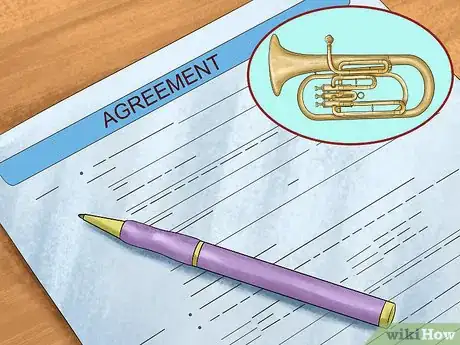


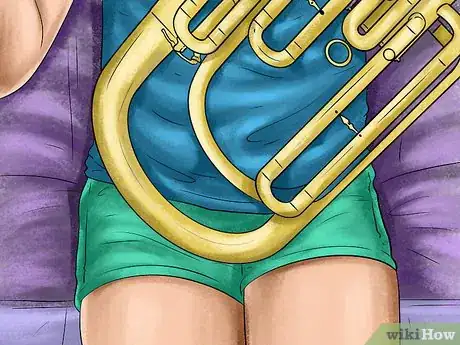




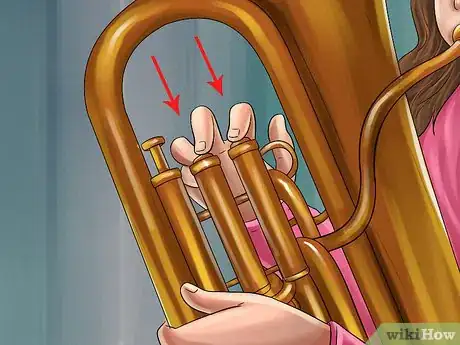
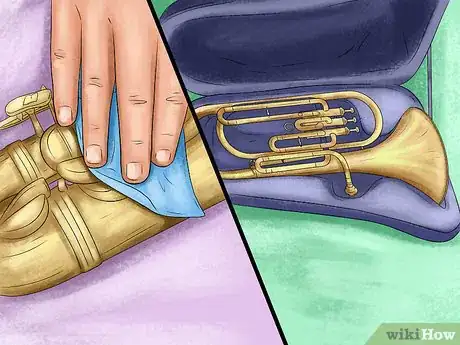
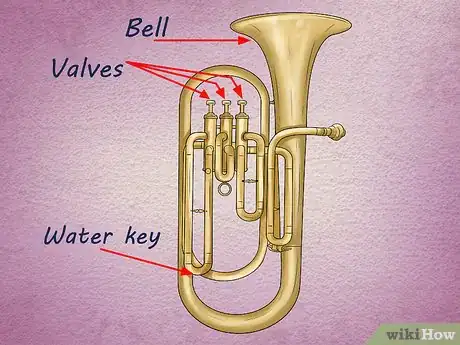



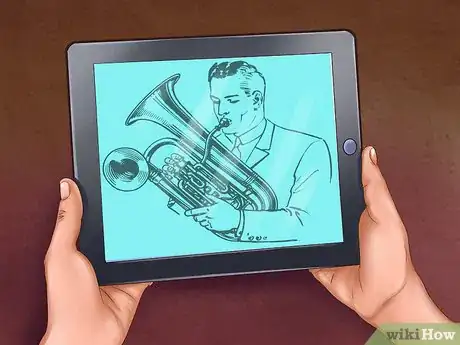



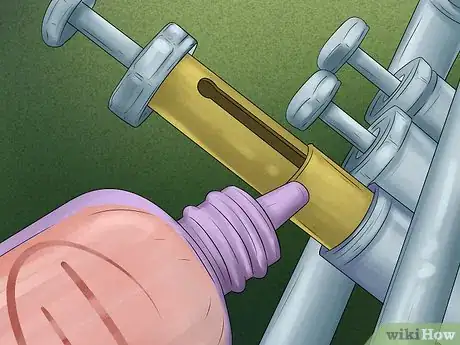
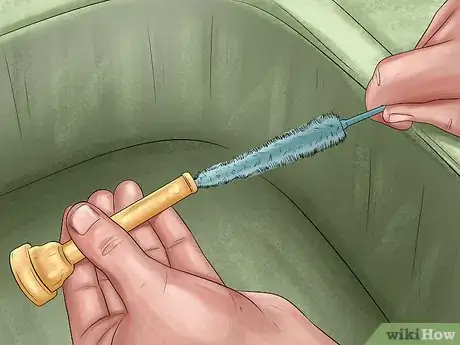
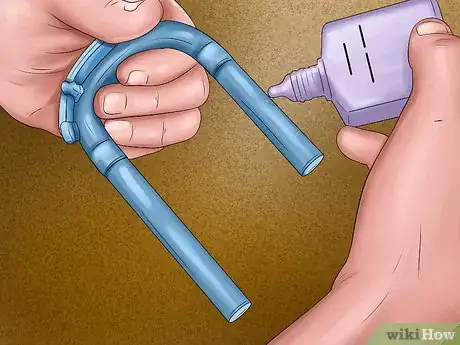
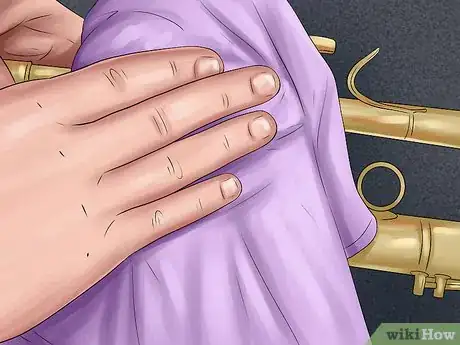









-Step-17-Version-4.webp)


















































